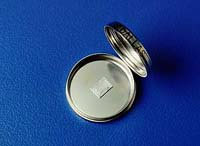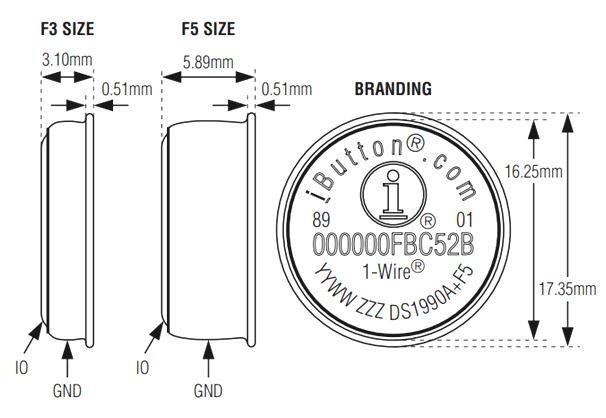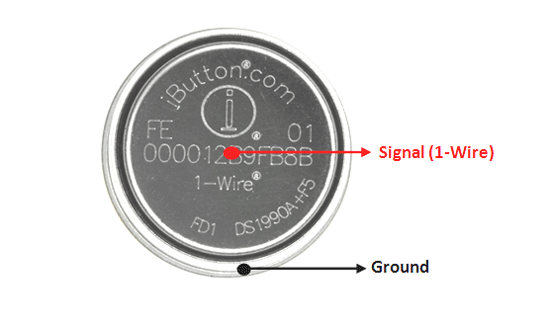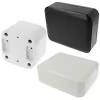DS19990A iButton
Pin Identification and Description
|
No: |
Pin Name |
Description |
|
1 |
Signal/IO |
Data is sent and received though this pin a.k.a IO pin |
|
2 |
Ground |
Common ground pin |
DS1990A iButton Specifications
- Operating Voltage: 2.8V to 6V
- Communication protocol: 1-Wire
- Identifier: 64-bit registration number (laser engraved)
- Data Read time: 5ms
- Sink current 20mA
- One wire Pull-Up Voltage: 2.8V to 6V
- Maximum Input low Voltage: 0.3V
- Minimum Input high Voltage: 2.2V
Other iButton Related Accessories
|
Name |
Usage |
|
DS9490R |
Connector to connect iButton with Laptop / Compuer |
|
DS9092 |
iButton Probe to connect the iButton to other embedded circuits |
|
DS9101 |
Clip to store/carry the iButton |
|
DS9096P |
Holder to snap in iButton during travel or rugged usage. |
Other iButton form Dallas
DS1972, DS1982, DS1920, DS1991
What is an iButton and where to use it?
The iButton is a small coin cell type device which has a unique un-alterable identifier laser engraved into it. For instance the DS1990A iButton has a 64-bit unique address and this address can be read by a computer or even a microcontroller like Arduino for that matter. This communication happens though 1-Wire protocol.

The Device is actually a stainless steel can but has a silicon IC inside as shown above, as a user/programmer we need not open the can since the IC is already in contact with the metal can. The Upper layer of the can is the Signal (IO) and the side of the metal gives as the ground wire as shown in the pinout diagram on top of the page. Both the IO and Ground signal is separate by a grommet on the can.
Since the IC inside is covered by a stainless steel can the construction is pretty rugged. This makes to suitable for wear and tear application. And the unique ID can be easily read by touching it on the reader. Apart from this some models of iButton can also be used for data logging. So if you are looking for a rugged portable device to be used in harsh environments to read or write data with low power then iButtons might be of interest to you.
Types of iButtons
The concept of iButton was introduced by Maxim Integrated who also invented the 1-Wire communication technology. Since launch they have released about 20 different types of iButtons which is unique in its own way. But to categorise broadly they can be classified as
- Address only – can be used only to read the unique identifier
- Memory – can read/write data that can be stored in memory
- Real Time clock – has an inbuilt RTC
- Secure – Cannot be hacked used where digital currency is involved
- Data Loggers - Used for temperature/ humidity or other logging applications
Where to use DS1990A
The DS1990A is a Address only type iButton meaning you can only read the 64-bit unique identifier from it and you cannot write anything inside. The read time for this device is only 5ms and since it follows one-wire communication protocol the user only has to touch the device onto the reader. This makes it ideal for entry restriction projects or in scenarios where a certain action has to be taken when reading the value form the iButton, like opening a valve triggering a siren etc..
How to use the DS1990A
The DS199A cannot be used on its own; it requires a probe/connector to connect the device to its reader like a computer or an embedded hardware. There are many ways to use a DS1990A, if you are planning to use it with a computer then you need not worry a lot since the hardware and software for it is already provided by Maxim integrated. The connector called DS9490R can be directly used to connect the DS1990A with the USB port of the computer and the Java application running on computer can be directly used to read the data from the iButton. You can read the Quick Start Guide from Maxim if you are curious to know more.
The story is slightly different when you are trying to use the module with a embedded application like ATmega (Arduino), PIC or whatever MCU/MPU. Here you have to use a probe like the DS9092L to connect the iButton to the hardware. Then from there you have to program the hardware (MCU/MPU) to use the 1-Wire protocol to read the data from the iButton. A typical application circuit is shown below.

As you can see the communication requires only two wires out of which one is a Ground wire. The signal wire (IO Wire) is pulled high with a pull up resistor of 1K. The DS1990A can operate from 2.8V to 6V hence it is suitable to operate with 3.3V and 5V microcontroller platform.
The procedure to use one-wire protocol to read data can be found at the datasheet. Basically the GPIO pin shown above toggled to on state and off state to request for data from the iButton device the time duration and voltage level can be found at the datasheet on page 8 as mentioned before.
Applications
- Security system
- Product or resource identification
- Inventory control
- Access Control
Dimensions of the DS1990












